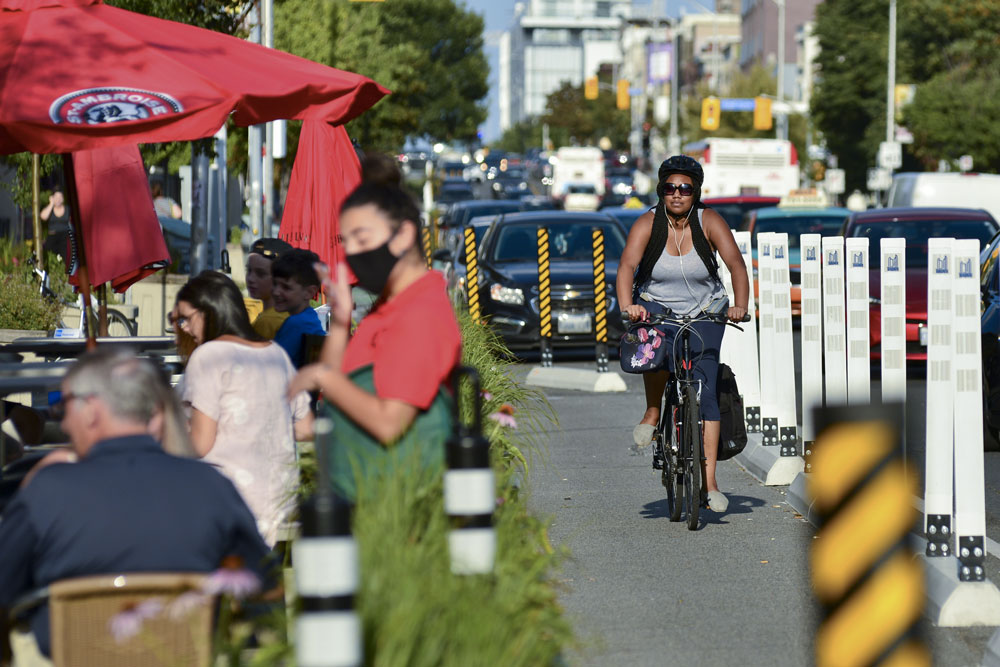
By vastly altering the way Torontonians experienced public life, the COVID-19 pandemic demanded that we critically reconsider how we use our streets and public spaces. ActiveTO was launched in response to the closures to ensure pedestrians and individuals who cycle have space to move around, walk and cycle. Approved by City Council on May 28, 2020, ActiveTO transformed city streets by closing major road corridors to vehicle traffic, expanding Toronto’s cycling network, calming local street traffic in areas across the city, and redesigning streetside infrastructure in several locations.
In 2021, initial evaluation of the programs was conducted by TCAT, Park People, and 8 80 Cities, in collaboration with the City of Toronto. During the summer of 2022, further evaluation of the ActiveTO programs was conducted by Ethan Sansom at The Centre for Active Transportation, using survey data collected from ActiveTO installations across Toronto.
The impacts of the ActiveTO program were positive and encouraging. The data demonstrated that the ActiveTO installations encouraged mode share away from driving towards cycling and that individuals who cycle expressed increased perceptions of safety, which led them to visit the installations more often. At the same time, the findings demonstrated important areas for improvement: proximity matters, and in order to achieve the greatest community and equity impacts, these programs cannot be clustered in the downtown core.
Replicating the successes of programs like ActiveTO, and refining the areas of improvement of such programs, will lead to a better Toronto and improve the health and mobility of Torontonians of all ages, races, incomes and locations
Here are the key findings from our evaluation Looking at Toronto’s Transportation Response to the COVID-19 Pandemic:
Individuals who cycle perceived the greatest benefits from ActiveTO
- On Quiet Streets, 74% of survey respondents felt an increase in their safety and ability to physically distance themselves, compared to 66% on Danforth
- More than 60% of individuals who cycle said that they visited more often because of the installation of Complete Streets
ActiveTO programs encouraged mode share away from driving towards cycling
- With an expanded cycling network and an increased number of individuals who cycle safely, Torontonians will ride. On Major Road Closures, 18% of individuals who cycle either discovered or rediscovered cycling
- On Complete Streets Pilot Projects, 276 survey respondents changed their primary mode of transport during the pandemic, with 44% of drivers shifting to either walking or cycling on Yonge, compared to 31% on Danforth
Proximity Matters
- More than half of survey respondents lived in Downtown Toronto where the Major Road Closures and Complete Streets pilot projects took place, with over 70% living 5 km away from a road closure
- Demographics of ActiveTO visitors and Downtown Toronto were similar, although visitors were more likely to have a higher income of $100,000 or more and did not identify as BIPOC, while less than 30% identified as BIPOC, compared to 52% in the 2016 Census
- As a result, in the future, ActiveTO and other street improvement projects must target specific neighbourhoods across the city for a range of voices from diverse communities to articulate any comments and concerns
ActiveTO programs broadly improved safety and physical distancing
- Most survey respondents agreed they felt the program improved their overall safety and ability to physically distance when sharing the street, while more than 85% felt the same when on the closure
- 98% of Complete Street respondents felt safer using the street, compared to over 60% of Quiet Streets respondents
Accessibility impacts are mixed
- ActiveTO visitors reported there were no improvements made for accessibility, including the 81% surveyed on Complete Street Pilots who saw no change
- 52% of Quiet Streets respondents who used mobility devices to travel argued their safety had improved as part of the program, while 43% said the opposite
You can read the full report here.
